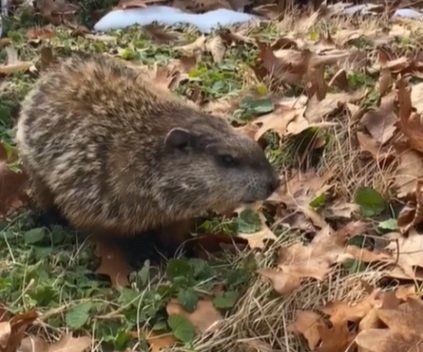
Living With Groundhog Neighbors
If you find a sick, injured or orphaned groundhog, learn what to do here!
Groundhogs, also known as woodchucks or whistle pigs, are a common animal in our Pennsylvania backyards. Their large size makes them easy to spot in open habitats, and their burrows can become a worry for many people. Many types of wildlife rely on groundhog burrows, so it is important we learn to care about our neighbors!
Groundhogs are a Rabies Vector Species (RVS). Any mammal (including humans) can get rabies, but cases are most commonly reported in an RVS like foxes, raccoons, skunks, groundhogs and bats, or even in stray cats and dogs. You should avoid handling RVS, but if necessary, always handle it with caution by wearing thick gloves. An RVS cannot be relocated in PA. If trapping for any of these species, they must be killed or released on the property where it was trapped.
How Can I Prevent Groundhogs From Burrowing Under My House, Shed or Walkway?
When choosing a burrowing location, groundhogs will look for structures that can prevent invasion from predators. Human-made structures, like houses and walkways, provide sturdy structural ceilings for groundhog burrows. Groundhog tunnels usually do not cause any significant damage, and their occupancy can even improve soil quality.
In situations where tolerance of the burrow is not possible, deterrence strategies can be used. Groundhogs will rarely abandon a burrow since they have multiple tunnels, chambers and openings. Therefore, you should target a specific section of the burrow for the most success. Covering a specific opening with wire mesh can prevent the groundhog from using a problematic section of their tunnel. Before placing the barrier, you will need to ensure no animals will be trapped inside. To do this, you need to dig a trench (1’x1’) around the perimeter of the structure you’re protecting and monitor the use of any revealed tunnels or chambers for two days. Stuff these chambers or tunnels with newspaper to prevent their use, then you can place the barrier.
Any barrier placement must occur during the season where groundhogs are active (March-September). Closing off a burrow during the winter could trap a hibernating groundhog inside.
How Can I Stop Groundhogs From Eating My Garden or Crops?
Groundhogs are both excellent diggers and climbers, so any barriers around your gardens must be tall and deep. Barriers should extend 1' foot below ground level and have an “L” shape. Barriers also need to be at least 3 feet tall with a wobbly top. Alternatively, motion-activated sprinklers could be used to deter the groundhog. You can also plant extra crops to assist with loss to wildlife.
If I Accidentally Dig up a Groundhog Den, Are the Babies Orphaned?
Groundhog burrows are extensive, so mother groundhogs are usually able to relocate their young to another section of the burrow. Young should be left in the area where they were found, so the mother can easily find them again and relocate. If the mother doesn’t reclaim her young after three or four daylight hours, reach out to our hotline!
Do you still have questions after reading the information above? Contact us or a local wildlife rehabilitator!
Have you found this FREE information helpful? Help support our work and expand our services by giving a gift.
Resources
Wild Neighbors: The Humane Approach to Living with Wildlife by John Hadidian. The Humane Society of the United States

